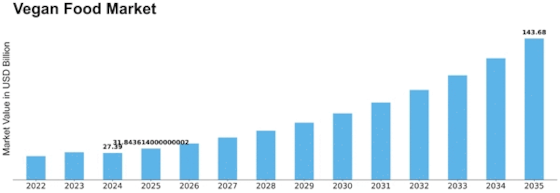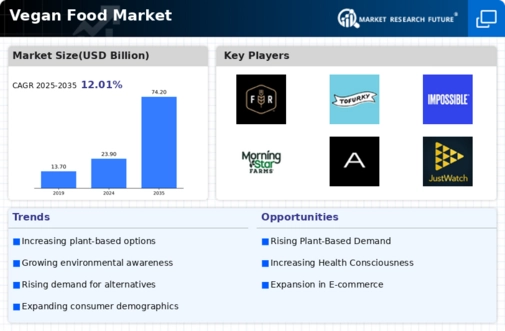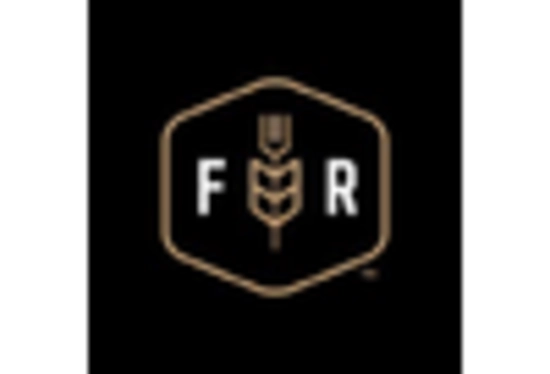-
FACTOR ANALYSIS
-
\r\n\r\n\r\nValue chain Analysis
-
\r\n\r\n\r\nPorter's
-
Five Forces Analysis
-
\r\n\r\n\r\nBargaining Power of Suppliers
-
\r\n\r\n\r\nBargaining
-
Power of Buyers
-
\r\n\r\n\r\nThreat of New Entrants
-
\r\n\r\n\r\nThreat
-
of Substitutes
-
\r\n\r\n\r\nIntensity of Rivalry
-
\r\n\r\n\r\n\r\n\r\nCOVID-19
-
Impact Analysis
-
\r\n\r\n\r\nMarket Impact Analysis
-
\r\n\r\n\r\nRegional
-
Impact
-
\r\n\r\n\r\nOpportunity and Threat Analysis
-
\r\n\r\n\r\n\r\n\r\n\r\n\r\n\r\n\r\nVegan
-
Food Market, BY Product Type (USD Billion)
-
\r\n\r\n\r\nVegan
-
Meat
-
\r\n\r\n\r\nDairy Alternatives
-
\r\n\r\n\r\nPlant-Based
-
Snacks
-
\r\n\r\n\r\nVegan Sauces
-
\r\n\r\n\r\nVegan
-
Bakery Products
-
\r\n\r\n\r\n\r\n\r\nVegan Food
-
Market, BY Distribution Channel (USD Billion)
-
\r\n\r\n\r\nSupermarkets/Hypermarkets
-
\r\n\r\n\r\nOnline
-
Retail
-
\r\n\r\n\r\nSpecialty Stores
-
\r\n\r\n\r\nConvenience
-
Stores
-
\r\n\r\n\r\n\r\n\r\nVegan Food Market, BY
-
Form (USD Billion)
-
\r\n\r\n\r\nFrozen
-
\r\n\r\n\r\nChilled
-
\r\n\r\n\r\nShelf-Stable
-
\r\n\r\n\r\n\r\n\r\nVegan
-
Food Market, BY Consumer Age Group (USD Billion)
-
\r\n\r\n\r\nChildren
-
\r\n\r\n\r\nAdults
-
\r\n\r\n\r\nSeniors
-
\r\n\r\n\r\n\r\n\r\nVegan
-
Food Market, BY Regional (USD Billion)
-
\r\n\r\n\r\nNorth
-
America
-
\r\n\r\n\r\nUS
-
\r\n\r\n\r\nCanada
-
\r\n\r\n\r\n\r\n\r\nEurope
-
\r\n\r\n\r\nGermany
-
\r\n\r\n\r\nUK
-
\r\n\r\n\r\nFrance
-
\r\n\r\n\r\nRussia
-
\r\n\r\n\r\nItaly
-
\r\n\r\n\r\nSpain
-
\r\n\r\n\r\nRest
-
of Europe
-
\r\n\r\n\r\n\r\n\r\nAPAC
-
\r\n\r\n\r\nChina
-
\r\n\r\n\r\nIndia
-
\r\n\r\n\r\nJapan
-
\r\n\r\n\r\nSouth
-
Korea
-
\r\n\r\n\r\nMalaysia
-
\r\n\r\n\r\nThailand
-
\r\n\r\n\r\nIndonesia
-
\r\n\r\n\r\nRest
-
of APAC
-
\r\n\r\n\r\n\r\n\r\nSouth America
-
\r\n\r\n\r\nBrazil
-
\r\n\r\n\r\nMexico
-
\r\n\r\n\r\nArgentina
-
\r\n\r\n\r\nRest
-
of South America
-
\r\n\r\n\r\n\r\n\r\nMEA
-
\r\n\r\n\r\nGCC
-
Countries
-
\r\n\r\n\r\nSouth Africa
-
\r\n\r\n\r\nRest
-
of MEA
-
\r\n\r\n\r\n\r\n\r\n\r\n\r\n
-
\r\n
-
\r\n\r\n\r\nCompetitive
-
Landscape
-
\r\n\r\n\r\nOverview
-
\r\n\r\n\r\nCompetitive
-
Analysis
-
\r\n\r\n\r\nMarket share Analysis
-
\r\n\r\n\r\nMajor
-
Growth Strategy in the Vegan Food Market
-
\r\n\r\n\r\nCompetitive
-
Benchmarking
-
\r\n\r\n\r\nLeading Players in Terms of Number of Developments
-
in the Vegan Food Market
-
\r\n\r\n\r\nKey developments and growth
-
strategies
-
\r\n\r\n\r\nNew Product Launch/Service Deployment
-
\r\n\r\n\r\nMerger
-
& Acquisitions
-
\r\n\r\n\r\nJoint Ventures
-
\r\n\r\n\r\n\r\n\r\nMajor
-
Players Financial Matrix
-
\r\n\r\n\r\nSales and Operating Income
-
\r\n\r\n\r\nMajor
-
Players R&D Expenditure. 2023
-
\r\n\r\n\r\n\r\n\r\n\r\n\r\nCompany
-
Profiles
-
\r\n\r\n\r\nDanone
-
\r\n\r\n\r\nFinancial
-
Overview
-
\r\n\r\n\r\nProducts Offered
-
\r\n\r\n\r\nKey
-
Developments
-
\r\n\r\n\r\nSWOT Analysis
-
\r\n\r\n\r\nKey
-
Strategies
-
\r\n\r\n\r\n\r\n\r\nUnilever
-
\r\n\r\n\r\nFinancial
-
Overview
-
\r\n\r\n\r\nProducts Offered
-
\r\n\r\n\r\nKey
-
Developments
-
\r\n\r\n\r\nSWOT Analysis
-
\r\n\r\n\r\nKey
-
Strategies
-
\r\n\r\n\r\n\r\n\r\nLightlife Foods
-
\r\n\r\n\r\nFinancial
-
Overview
-
\r\n\r\n\r\nProducts Offered
-
\r\n\r\n\r\nKey
-
Developments
-
\r\n\r\n\r\nSWOT Analysis
-
\r\n\r\n\r\nKey
-
Strategies
-
\r\n\r\n\r\n\r\n\r\nImpossible Foods
-
\r\n\r\n\r\nFinancial
-
Overview
-
\r\n\r\n\r\nProducts Offered
-
\r\n\r\n\r\nKey
-
Developments
-
\r\n\r\n\r\nSWOT Analysis
-
\r\n\r\n\r\nKey
-
Strategies
-
\r\n\r\n\r\n\r\n\r\nNestle
-
\r\n\r\n\r\nFinancial
-
Overview
-
\r\n\r\n\r\nProducts Offered
-
\r\n\r\n\r\nKey
-
Developments
-
\r\n\r\n\r\nSWOT Analysis
-
\r\n\r\n\r\nKey
-
Strategies
-
\r\n\r\n\r\n\r\n\r\nMiyoko's Creamery
-
\r\n\r\n\r\nFinancial
-
Overview
-
\r\n\r\n\r\nProducts Offered
-
\r\n\r\n\r\nKey
-
Developments
-
\r\n\r\n\r\nSWOT Analysis
-
\r\n\r\n\r\nKey
-
Strategies
-
\r\n\r\n\r\n\r\n\r\nAmy's Kitchen
-
\r\n\r\n\r\nFinancial
-
Overview
-
\r\n\r\n\r\nProducts Offered
-
\r\n\r\n\r\nKey
-
Developments
-
\r\n\r\n\r\nSWOT Analysis
-
\r\n\r\n\r\nKey
-
Strategies
-
\r\n\r\n\r\n\r\n\r\nQuorn Foods
-
\r\n\r\n\r\nFinancial
-
Overview
-
\r\n\r\n\r\nProducts Offered
-
\r\n\r\n\r\nKey
-
Developments
-
\r\n\r\n\r\nSWOT Analysis
-
\r\n\r\n\r\nKey
-
Strategies
-
\r\n\r\n\r\n\r\n\r\nField Roast
-
\r\n\r\n\r\nFinancial
-
Overview
-
\r\n\r\n\r\nProducts Offered
-
\r\n\r\n\r\nKey
-
Developments
-
\r\n\r\n\r\nSWOT Analysis
-
\r\n\r\n\r\nKey
-
Strategies
-
\r\n\r\n\r\n\r\n\r\nGardien
-
\r\n\r\n\r\nFinancial
-
Overview
-
\r\n\r\n\r\nProducts Offered
-
\r\n\r\n\r\nKey
-
Developments
-
\r\n\r\n\r\nSWOT Analysis
-
\r\n\r\n\r\nKey
-
Strategies
-
\r\n\r\n\r\n\r\n\r\nOatly
-
\r\n\r\n\r\nFinancial
-
Overview
-
\r\n\r\n\r\nProducts Offered
-
\r\n\r\n\r\nKey
-
Developments
-
\r\n\r\n\r\nSWOT Analysis
-
\r\n\r\n\r\nKey
-
Strategies
-
\r\n\r\n\r\n\r\n\r\nDaiya Foods
-
\r\n\r\n\r\nFinancial
-
Overview
-
\r\n\r\n\r\nProducts Offered
-
\r\n\r\n\r\nKey
-
Developments
-
\r\n\r\n\r\nSWOT Analysis
-
\r\n\r\n\r\nKey
-
Strategies
-
\r\n\r\n\r\n\r\n\r\nBeyond Meat
-
\r\n\r\n\r\nFinancial
-
Overview
-
\r\n\r\n\r\nProducts Offered
-
\r\n\r\n\r\nKey
-
Developments
-
\r\n\r\n\r\nSWOT Analysis
-
\r\n\r\n\r\nKey
-
Strategies
-
\r\n\r\n\r\n\r\n\r\nTofurky
-
\r\n\r\n\r\nFinancial
-
Overview
-
\r\n\r\n\r\nProducts Offered
-
\r\n\r\n\r\nKey
-
Developments
-
\r\n\r\n\r\nSWOT Analysis
-
\r\n\r\n\r\nKey
-
Strategies
-
\r\n\r\n\r\n\r\n\r\n\r\n\r\nAppendix
-
\r\n\r\n\r\nReferences
-
\r\n\r\n\r\nRelated
-
Reports
-
\r\n\r\n\r\n\r\n\r\nLIST Of tables
-
\r\n
-
\r\n\r\n\r\nLIST
-
OF ASSUMPTIONS
-
\r\n\r\n\r\nNorth America Vegan Food Market SIZE ESTIMATES
-
& FORECAST, BY PRODUCT TYPE, 2019-2035 (USD Billions)
-
\r\n\r\n\r\nNorth
-
America Vegan Food Market SIZE ESTIMATES & FORECAST, BY DISTRIBUTION CHANNEL,
-
\r\n\r\n\r\nNorth America Vegan Food Market
-
SIZE ESTIMATES & FORECAST, BY FORM, 2019-2035 (USD Billions)
-
\r\n\r\n\r\nNorth
-
America Vegan Food Market SIZE ESTIMATES & FORECAST, BY CONSUMER AGE GROUP,
-
\r\n\r\n\r\nNorth America Vegan Food Market
-
SIZE ESTIMATES & FORECAST, BY REGIONAL, 2019-2035 (USD Billions)
-
\r\n\r\n\r\nUS
-
Vegan Food Market SIZE ESTIMATES & FORECAST, BY PRODUCT TYPE, 2019-2035 (USD
-
Billions)
-
\r\n\r\n\r\nUS Vegan Food Market SIZE ESTIMATES & FORECAST,
-
BY DISTRIBUTION CHANNEL, 2019-2035 (USD Billions)
-
\r\n\r\n\r\nUS
-
Vegan Food Market SIZE ESTIMATES & FORECAST, BY FORM, 2019-2035 (USD Billions)
-
\r\n\r\n\r\nUS
-
Vegan Food Market SIZE ESTIMATES & FORECAST, BY CONSUMER AGE GROUP, 2019-2035
-
(USD Billions)
-
\r\n\r\n\r\nUS Vegan Food Market SIZE ESTIMATES &
-
FORECAST, BY REGIONAL, 2019-2035 (USD Billions)
-
\r\n\r\n\r\nCanada
-
Vegan Food Market SIZE ESTIMATES & FORECAST, BY PRODUCT TYPE, 2019-2035 (USD
-
Billions)
-
\r\n\r\n\r\nCanada Vegan Food Market SIZE ESTIMATES &
-
FORECAST, BY DISTRIBUTION CHANNEL, 2019-2035 (USD Billions)
-
\r\n\r\n\r\nCanada
-
Vegan Food Market SIZE ESTIMATES & FORECAST, BY FORM, 2019-2035 (USD Billions)
-
\r\n\r\n\r\nCanada
-
Vegan Food Market SIZE ESTIMATES & FORECAST, BY CONSUMER AGE GROUP, 2019-2035
-
(USD Billions)
-
\r\n\r\n\r\nCanada Vegan Food Market SIZE ESTIMATES
-
& FORECAST, BY REGIONAL, 2019-2035 (USD Billions)
-
\r\n\r\n\r\nEurope
-
Vegan Food Market SIZE ESTIMATES & FORECAST, BY PRODUCT TYPE, 2019-2035 (USD
-
Billions)
-
\r\n\r\n\r\nEurope Vegan Food Market SIZE ESTIMATES &
-
FORECAST, BY DISTRIBUTION CHANNEL, 2019-2035 (USD Billions)
-
\r\n\r\n\r\nEurope
-
Vegan Food Market SIZE ESTIMATES & FORECAST, BY FORM, 2019-2035 (USD Billions)
-
\r\n\r\n\r\nEurope
-
Vegan Food Market SIZE ESTIMATES & FORECAST, BY CONSUMER AGE GROUP, 2019-2035
-
(USD Billions)
-
\r\n\r\n\r\nEurope Vegan Food Market SIZE ESTIMATES
-
& FORECAST, BY REGIONAL, 2019-2035 (USD Billions)
-
\r\n\r\n\r\nGermany
-
Vegan Food Market SIZE ESTIMATES & FORECAST, BY PRODUCT TYPE, 2019-2035 (USD
-
Billions)
-
\r\n\r\n\r\nGermany Vegan Food Market SIZE ESTIMATES &
-
FORECAST, BY DISTRIBUTION CHANNEL, 2019-2035 (USD Billions)
-
\r\n\r\n\r\nGermany
-
Vegan Food Market SIZE ESTIMATES & FORECAST, BY FORM, 2019-2035 (USD Billions)
-
\r\n\r\n\r\nGermany
-
Vegan Food Market SIZE ESTIMATES & FORECAST, BY CONSUMER AGE GROUP, 2019-2035
-
(USD Billions)
-
\r\n\r\n\r\nGermany Vegan Food Market SIZE ESTIMATES
-
& FORECAST, BY REGIONAL, 2019-2035 (USD Billions)
-
\r\n\r\n\r\nUK
-
Vegan Food Market SIZE ESTIMATES & FORECAST, BY PRODUCT TYPE, 2019-2035 (USD
-
Billions)
-
\r\n\r\n\r\nUK Vegan Food Market SIZE ESTIMATES & FORECAST,
-
BY DISTRIBUTION CHANNEL, 2019-2035 (USD Billions)
-
\r\n\r\n\r\nUK
-
Vegan Food Market SIZE ESTIMATES & FORECAST, BY FORM, 2019-2035 (USD Billions)
-
\r\n\r\n\r\nUK
-
Vegan Food Market SIZE ESTIMATES & FORECAST, BY CONSUMER AGE GROUP, 2019-2035
-
(USD Billions)
-
\r\n\r\n\r\nUK Vegan Food Market SIZE ESTIMATES &
-
FORECAST, BY REGIONAL, 2019-2035 (USD Billions)
-
\r\n\r\n\r\nFrance
-
Vegan Food Market SIZE ESTIMATES & FORECAST, BY PRODUCT TYPE, 2019-2035 (USD
-
Billions)
-
\r\n\r\n\r\nFrance Vegan Food Market SIZE ESTIMATES &
-
FORECAST, BY DISTRIBUTION CHANNEL, 2019-2035 (USD Billions)
-
\r\n\r\n\r\nFrance
-
Vegan Food Market SIZE ESTIMATES & FORECAST, BY FORM, 2019-2035 (USD Billions)
-
\r\n\r\n\r\nFrance
-
Vegan Food Market SIZE ESTIMATES & FORECAST, BY CONSUMER AGE GROUP, 2019-2035
-
(USD Billions)
-
\r\n\r\n\r\nFrance Vegan Food Market SIZE ESTIMATES
-
& FORECAST, BY REGIONAL, 2019-2035 (USD Billions)
-
\r\n\r\n\r\nRussia
-
Vegan Food Market SIZE ESTIMATES & FORECAST, BY PRODUCT TYPE, 2019-2035 (USD
-
Billions)
-
\r\n\r\n\r\nRussia Vegan Food Market SIZE ESTIMATES &
-
FORECAST, BY DISTRIBUTION CHANNEL, 2019-2035 (USD Billions)
-
\r\n\r\n\r\nRussia
-
Vegan Food Market SIZE ESTIMATES & FORECAST, BY FORM, 2019-2035 (USD Billions)
-
\r\n\r\n\r\nRussia
-
Vegan Food Market SIZE ESTIMATES & FORECAST, BY CONSUMER AGE GROUP, 2019-2035
-
(USD Billions)
-
\r\n\r\n\r\nRussia Vegan Food Market SIZE ESTIMATES
-
& FORECAST, BY REGIONAL, 2019-2035 (USD Billions)
-
\r\n\r\n\r\nItaly
-
Vegan Food Market SIZE ESTIMATES & FORECAST, BY PRODUCT TYPE, 2019-2035 (USD
-
Billions)
-
\r\n\r\n\r\nItaly Vegan Food Market SIZE ESTIMATES &
-
FORECAST, BY DISTRIBUTION CHANNEL, 2019-2035 (USD Billions)
-
\r\n\r\n\r\nItaly
-
Vegan Food Market SIZE ESTIMATES & FORECAST, BY FORM, 2019-2035 (USD Billions)
-
\r\n\r\n\r\nItaly
-
Vegan Food Market SIZE ESTIMATES & FORECAST, BY CONSUMER AGE GROUP, 2019-2035
-
(USD Billions)
-
\r\n\r\n\r\nItaly Vegan Food Market SIZE ESTIMATES
-
& FORECAST, BY REGIONAL, 2019-2035 (USD Billions)
-
\r\n\r\n\r\nSpain
-
Vegan Food Market SIZE ESTIMATES & FORECAST, BY PRODUCT TYPE, 2019-2035 (USD
-
Billions)
-
\r\n\r\n\r\nSpain Vegan Food Market SIZE ESTIMATES &
-
FORECAST, BY DISTRIBUTION CHANNEL, 2019-2035 (USD Billions)
-
\r\n\r\n\r\nSpain
-
Vegan Food Market SIZE ESTIMATES & FORECAST, BY FORM, 2019-2035 (USD Billions)
-
\r\n\r\n\r\nSpain
-
Vegan Food Market SIZE ESTIMATES & FORECAST, BY CONSUMER AGE GROUP, 2019-2035
-
(USD Billions)
-
\r\n\r\n\r\nSpain Vegan Food Market SIZE ESTIMATES
-
& FORECAST, BY REGIONAL, 2019-2035 (USD Billions)
-
\r\n\r\n\r\nRest
-
of Europe Vegan Food Market SIZE ESTIMATES & FORECAST, BY PRODUCT TYPE, 2019-2035
-
(USD Billions)
-
\r\n\r\n\r\nRest of Europe Vegan Food Market SIZE
-
ESTIMATES & FORECAST, BY DISTRIBUTION CHANNEL, 2019-2035 (USD Billions)
-
\r\n\r\n\r\nRest
-
of Europe Vegan Food Market SIZE ESTIMATES & FORECAST, BY FORM, 2019-2035 (USD
-
Billions)
-
\r\n\r\n\r\nRest of Europe Vegan Food Market SIZE ESTIMATES
-
& FORECAST, BY CONSUMER AGE GROUP, 2019-2035 (USD Billions)
-
\r\n\r\n\r\nRest
-
of Europe Vegan Food Market SIZE ESTIMATES & FORECAST, BY REGIONAL, 2019-2035
-
(USD Billions)
-
\r\n\r\n\r\nAPAC Vegan Food Market SIZE ESTIMATES
-
& FORECAST, BY PRODUCT TYPE, 2019-2035 (USD Billions)
-
\r\n\r\n\r\nAPAC
-
Vegan Food Market SIZE ESTIMATES & FORECAST, BY DISTRIBUTION CHANNEL, 2019-2035
-
(USD Billions)
-
\r\n\r\n\r\nAPAC Vegan Food Market SIZE ESTIMATES
-
& FORECAST, BY FORM, 2019-2035 (USD Billions)
-
\r\n\r\n\r\nAPAC
-
Vegan Food Market SIZE ESTIMATES & FORECAST, BY CONSUMER AGE GROUP, 2019-2035
-
(USD Billions)
-
\r\n\r\n\r\nAPAC Vegan Food Market SIZE ESTIMATES
-
& FORECAST, BY REGIONAL, 2019-2035 (USD Billions)
-
\r\n\r\n\r\nChina
-
Vegan Food Market SIZE ESTIMATES & FORECAST, BY PRODUCT TYPE, 2019-2035 (USD
-
Billions)
-
\r\n\r\n\r\nChina Vegan Food Market SIZE ESTIMATES &
-
FORECAST, BY DISTRIBUTION CHANNEL, 2019-2035 (USD Billions)
-
\r\n\r\n\r\nChina
-
Vegan Food Market SIZE ESTIMATES & FORECAST, BY FORM, 2019-2035 (USD Billions)
-
\r\n\r\n\r\nChina
-
Vegan Food Market SIZE ESTIMATES & FORECAST, BY CONSUMER AGE GROUP, 2019-2035
-
(USD Billions)
-
\r\n\r\n\r\nChina Vegan Food Market SIZE ESTIMATES
-
& FORECAST, BY REGIONAL, 2019-2035 (USD Billions)
-
\r\n\r\n\r\nIndia
-
Vegan Food Market SIZE ESTIMATES & FORECAST, BY PRODUCT TYPE, 2019-2035 (USD
-
Billions)
-
\r\n\r\n\r\nIndia Vegan Food Market SIZE ESTIMATES &
-
FORECAST, BY DISTRIBUTION CHANNEL, 2019-2035 (USD Billions)
-
\r\n\r\n\r\nIndia
-
Vegan Food Market SIZE ESTIMATES & FORECAST, BY FORM, 2019-2035 (USD Billions)
-
\r\n\r\n\r\nIndia
-
Vegan Food Market SIZE ESTIMATES & FORECAST, BY CONSUMER AGE GROUP, 2019-2035
-
(USD Billions)
-
\r\n\r\n\r\nIndia Vegan Food Market SIZE ESTIMATES
-
& FORECAST, BY REGIONAL, 2019-2035 (USD Billions)
-
\r\n\r\n\r\nJapan
-
Vegan Food Market SIZE ESTIMATES & FORECAST, BY PRODUCT TYPE, 2019-2035 (USD
-
Billions)
-
\r\n\r\n\r\nJapan Vegan Food Market SIZE ESTIMATES &
-
FORECAST, BY DISTRIBUTION CHANNEL, 2019-2035 (USD Billions)
-
\r\n\r\n\r\nJapan
-
Vegan Food Market SIZE ESTIMATES & FORECAST, BY FORM, 2019-2035 (USD Billions)
-
\r\n\r\n\r\nJapan
-
Vegan Food Market SIZE ESTIMATES & FORECAST, BY CONSUMER AGE GROUP, 2019-2035
-
(USD Billions)
-
\r\n\r\n\r\nJapan Vegan Food Market SIZE ESTIMATES
-
& FORECAST, BY REGIONAL, 2019-2035 (USD Billions)
-
\r\n\r\n\r\nSouth
-
Korea Vegan Food Market SIZE ESTIMATES & FORECAST, BY PRODUCT TYPE, 2019-2035
-
(USD Billions)
-
\r\n\r\n\r\nSouth Korea Vegan Food Market SIZE ESTIMATES
-
& FORECAST, BY DISTRIBUTION CHANNEL, 2019-2035 (USD Billions)
-
\r\n\r\n\r\nSouth
-
Korea Vegan Food Market SIZE ESTIMATES & FORECAST, BY FORM, 2019-2035 (USD Billions)
-
\r\n\r\n\r\nSouth
-
Korea Vegan Food Market SIZE ESTIMATES & FORECAST, BY CONSUMER AGE GROUP, 2019-2035
-
(USD Billions)
-
\r\n\r\n\r\nSouth Korea Vegan Food Market SIZE ESTIMATES
-
& FORECAST, BY REGIONAL, 2019-2035 (USD Billions)
-
\r\n\r\n\r\nMalaysia
-
Vegan Food Market SIZE ESTIMATES & FORECAST, BY PRODUCT TYPE, 2019-2035 (USD
-
Billions)
-
\r\n\r\n\r\nMalaysia Vegan Food Market SIZE ESTIMATES &
-
FORECAST, BY DISTRIBUTION CHANNEL, 2019-2035 (USD Billions)
-
\r\n\r\n\r\nMalaysia
-
Vegan Food Market SIZE ESTIMATES & FORECAST, BY FORM, 2019-2035 (USD Billions)
-
\r\n\r\n\r\nMalaysia
-
Vegan Food Market SIZE ESTIMATES & FORECAST, BY CONSUMER AGE GROUP, 2019-2035
-
(USD Billions)
-
\r\n\r\n\r\nMalaysia Vegan Food Market SIZE ESTIMATES
-
& FORECAST, BY REGIONAL, 2019-2035 (USD Billions)
-
\r\n\r\n\r\nThailand
-
Vegan Food Market SIZE ESTIMATES & FORECAST, BY PRODUCT TYPE, 2019-2035 (USD
-
Billions)
-
\r\n\r\n\r\nThailand Vegan Food Market SIZE ESTIMATES &
-
FORECAST, BY DISTRIBUTION CHANNEL, 2019-2035 (USD Billions)
-
\r\n\r\n\r\nThailand
-
Vegan Food Market SIZE ESTIMATES & FORECAST, BY FORM, 2019-2035 (USD Billions)
-
\r\n\r\n\r\nThailand
-
Vegan Food Market SIZE ESTIMATES & FORECAST, BY CONSUMER AGE GROUP, 2019-2035
-
(USD Billions)
-
\r\n\r\n\r\nThailand Vegan Food Market SIZE ESTIMATES
-
& FORECAST, BY REGIONAL, 2019-2035 (USD Billions)
-
\r\n\r\n\r\nIndonesia
-
Vegan Food Market SIZE ESTIMATES & FORECAST, BY PRODUCT TYPE, 2019-2035 (USD
-
Billions)
-
\r\n\r\n\r\nIndonesia Vegan Food Market SIZE ESTIMATES
-
& FORECAST, BY DISTRIBUTION CHANNEL, 2019-2035 (USD Billions)
-
\r\n\r\n\r\nIndonesia
-
Vegan Food Market SIZE ESTIMATES & FORECAST, BY FORM, 2019-2035 (USD Billions)
-
\r\n\r\n\r\nIndonesia
-
Vegan Food Market SIZE ESTIMATES & FORECAST, BY CONSUMER AGE GROUP, 2019-2035
-
(USD Billions)
-
\r\n\r\n\r\nIndonesia Vegan Food Market SIZE ESTIMATES
-
& FORECAST, BY REGIONAL, 2019-2035 (USD Billions)
-
\r\n\r\n\r\nRest
-
of APAC Vegan Food Market SIZE ESTIMATES & FORECAST, BY PRODUCT TYPE, 2019-2035
-
(USD Billions)
-
\r\n\r\n\r\nRest of APAC Vegan Food Market SIZE ESTIMATES
-
& FORECAST, BY DISTRIBUTION CHANNEL, 2019-2035 (USD Billions)
-
\r\n\r\n\r\nRest
-
of APAC Vegan Food Market SIZE ESTIMATES & FORECAST, BY FORM, 2019-2035 (USD
-
Billions)
-
\r\n\r\n\r\nRest of APAC Vegan Food Market SIZE ESTIMATES
-
& FORECAST, BY CONSUMER AGE GROUP, 2019-2035 (USD Billions)
-
\r\n\r\n\r\nRest
-
of APAC Vegan Food Market SIZE ESTIMATES & FORECAST, BY REGIONAL, 2019-2035
-
(USD Billions)
-
\r\n\r\n\r\nSouth America Vegan Food Market SIZE ESTIMATES
-
& FORECAST, BY PRODUCT TYPE, 2019-2035 (USD Billions)
-
\r\n\r\n\r\nSouth
-
America Vegan Food Market SIZE ESTIMATES & FORECAST, BY DISTRIBUTION CHANNEL,
-
\r\n\r\n\r\nSouth America Vegan Food Market
-
SIZE ESTIMATES & FORECAST, BY FORM, 2019-2035 (USD Billions)
-
\r\n\r\n\r\nSouth
-
America Vegan Food Market SIZE ESTIMATES & FORECAST, BY CONSUMER AGE GROUP,
-
\r\n\r\n\r\nSouth America Vegan Food Market
-
SIZE ESTIMATES & FORECAST, BY REGIONAL, 2019-2035 (USD Billions)
-
\r\n\r\n\r\nBrazil
-
Vegan Food Market SIZE ESTIMATES & FORECAST, BY PRODUCT TYPE, 2019-2035 (USD
-
Billions)
-
\r\n\r\n\r\nBrazil Vegan Food Market SIZE ESTIMATES &
-
FORECAST, BY DISTRIBUTION CHANNEL, 2019-2035 (USD Billions)
-
\r\n\r\n\r\nBrazil
-
Vegan Food Market SIZE ESTIMATES & FORECAST, BY FORM, 2019-2035 (USD Billions)
-
\r\n\r\n\r\nBrazil
-
Vegan Food Market SIZE ESTIMATES & FORECAST, BY CONSUMER AGE GROUP, 2019-2035
-
(USD Billions)
-
\r\n\r\n\r\nBrazil Vegan Food Market SIZE ESTIMATES
-
& FORECAST, BY REGIONAL, 2019-2035 (USD Billions)
-
\r\n\r\n\r\nMexico
-
Vegan Food Market SIZE ESTIMATES & FORECAST, BY PRODUCT TYPE, 2019-2035 (USD
-
Billions)
-
\r\n\r\n\r\nMexico Vegan Food Market SIZE ESTIMATES &
-
FORECAST, BY DISTRIBUTION CHANNEL, 2019-2035 (USD Billions)
-
\r\n\r\n\r\nMexico
-
Vegan Food Market SIZE ESTIMATES & FORECAST, BY FORM, 2019-2035 (USD Billions)
-
\r\n\r\n\r\nMexico
-
Vegan Food Market SIZE ESTIMATES & FORECAST, BY CONSUMER AGE GROUP, 2019-2035
-
(USD Billions)
-
\r\n\r\n\r\nMexico Vegan Food Market SIZE ESTIMATES
-
& FORECAST, BY REGIONAL, 2019-2035 (USD Billions)
-
\r\n\r\n\r\nArgentina
-
Vegan Food Market SIZE ESTIMATES & FORECAST, BY PRODUCT TYPE, 2019-2035 (USD
-
Billions)
-
\r\n\r\n\r\nArgentina Vegan Food Market SIZE ESTIMATES
-
& FORECAST, BY DISTRIBUTION CHANNEL, 2019-2035 (USD Billions)
-
\r\n\r\n\r\nArgentina
-
Vegan Food Market SIZE ESTIMATES & FORECAST, BY FORM, 2019-2035 (USD Billions)
-
\r\n\r\n\r\nArgentina
-
Vegan Food Market SIZE ESTIMATES & FORECAST, BY CONSUMER AGE GROUP, 2019-2035
-
(USD Billions)
-
\r\n\r\n\r\nArgentina Vegan Food Market SIZE ESTIMATES
-
& FORECAST, BY REGIONAL, 2019-2035 (USD Billions)
-
\r\n\r\n\r\nRest
-
of South America Vegan Food Market SIZE ESTIMATES & FORECAST, BY PRODUCT TYPE,
-
\r\n\r\n\r\nRest of South America Vegan
-
Food Market SIZE ESTIMATES & FORECAST, BY DISTRIBUTION CHANNEL, 2019-2035 (USD
-
Billions)
-
\r\n\r\n\r\nRest of South America Vegan Food Market SIZE
-
ESTIMATES & FORECAST, BY FORM, 2019-2035 (USD Billions)
-
\r\n\r\n\r\nRest
-
of South America Vegan Food Market SIZE ESTIMATES & FORECAST, BY CONSUMER AGE
-
GROUP, 2019-2035 (USD Billions)
-
\r\n\r\n\r\nRest of South America
-
Vegan Food Market SIZE ESTIMATES & FORECAST, BY REGIONAL, 2019-2035 (USD Billions)
-
\r\n\r\n\r\nMEA
-
Vegan Food Market SIZE ESTIMATES & FORECAST, BY PRODUCT TYPE, 2019-2035 (USD
-
Billions)
-
\r\n\r\n\r\nMEA Vegan Food Market SIZE ESTIMATES &
-
FORECAST, BY DISTRIBUTION CHANNEL, 2019-2035 (USD Billions)
-
\r\n\r\n\r\nMEA
-
Vegan Food Market SIZE ESTIMATES & FORECAST, BY FORM, 2019-2035 (USD Billions)
-
\r\n\r\n\r\nMEA
-
Vegan Food Market SIZE ESTIMATES & FORECAST, BY CONSUMER AGE GROUP, 2019-2035
-
(USD Billions)
-
\r\n\r\n\r\nMEA Vegan Food Market SIZE ESTIMATES &
-
FORECAST, BY REGIONAL, 2019-2035 (USD Billions)
-
\r\n\r\n\r\nGCC Countries
-
Vegan Food Market SIZE ESTIMATES & FORECAST, BY PRODUCT TYPE, 2019-2035 (USD
-
Billions)
-
\r\n\r\n\r\nGCC Countries Vegan Food Market SIZE ESTIMATES
-
& FORECAST, BY DISTRIBUTION CHANNEL, 2019-2035 (USD Billions)
-
\r\n\r\n\r\nGCC
-
Countries Vegan Food Market SIZE ESTIMATES & FORECAST, BY FORM, 2019-2035 (USD
-
Billions)
-
\r\n\r\n\r\nGCC Countries Vegan Food Market SIZE ESTIMATES
-
& FORECAST, BY CONSUMER AGE GROUP, 2019-2035 (USD Billions)
-
\r\n\r\n\r\nGCC
-
Countries Vegan Food Market SIZE ESTIMATES & FORECAST, BY REGIONAL, 2019-2035
-
(USD Billions)
-
\r\n\r\n\r\nSouth Africa Vegan Food Market SIZE ESTIMATES
-
& FORECAST, BY PRODUCT TYPE, 2019-2035 (USD Billions)
-
\r\n\r\n\r\nSouth
-
Africa Vegan Food Market SIZE ESTIMATES & FORECAST, BY DISTRIBUTION CHANNEL,
-
\r\n\r\n\r\nSouth Africa Vegan Food Market
-
SIZE ESTIMATES & FORECAST, BY FORM, 2019-2035 (USD Billions)
-
\r\n\r\n\r\nSouth
-
Africa Vegan Food Market SIZE ESTIMATES & FORECAST, BY CONSUMER AGE GROUP, 2019-2035
-
(USD Billions)
-
\r\n\r\n\r\nSouth Africa Vegan Food Market SIZE ESTIMATES
-
& FORECAST, BY REGIONAL, 2019-2035 (USD Billions)
-
\r\n\r\n\r\nRest
-
of MEA Vegan Food Market SIZE ESTIMATES & FORECAST, BY PRODUCT TYPE, 2019-2035
-
(USD Billions)
-
\r\n\r\n\r\nRest of MEA Vegan Food Market SIZE ESTIMATES
-
& FORECAST, BY DISTRIBUTION CHANNEL, 2019-2035 (USD Billions)
-
\r\n\r\n\r\nRest
-
of MEA Vegan Food Market SIZE ESTIMATES & FORECAST, BY FORM, 2019-2035 (USD
-
Billions)
-
\r\n\r\n\r\nRest of MEA Vegan Food Market SIZE ESTIMATES
-
& FORECAST, BY CONSUMER AGE GROUP, 2019-2035 (USD Billions)
-
\r\n\r\n\r\nRest
-
of MEA Vegan Food Market SIZE ESTIMATES & FORECAST, BY REGIONAL, 2019-2035 (USD
-
Billions)
-
\r\n\r\n\r\nPRODUCT LAUNCH/PRODUCT DEVELOPMENT/APPROVAL
-
\r\n\r\n\r\nACQUISITION/PARTNERSHIP
-
\r\n\r\n\r\n
-
\r\n
-
\r\n
-
\r\n
-
\r\n
-
\r\n
-
\r\n
-
\r\n
-
\r\n
-
\r\n
-
\r\n
-
\r\n
-
\r\n
-
\r\n
-
\r\n
-
\r\n
-
\r\n
-
\r\n
-
\r\n
-
\r\n
-
\r\n
-
\r\n
-
\r\n
-
\r\n
-
\r\n
-
\r\n
-
\r\n
-
\r\n
-
\r\n
-
\r\nLIST
-
Of figures
-
\r\n
-
\r\n\r\n\r\nMARKET SYNOPSIS
-
\r\n\r\n\r\nNORTH
-
AMERICA VEGAN FOOD MARKET ANALYSIS
-
\r\n\r\n\r\nUS VEGAN FOOD MARKET
-
ANALYSIS BY PRODUCT TYPE
-
\r\n\r\n\r\nUS VEGAN FOOD MARKET ANALYSIS
-
BY DISTRIBUTION CHANNEL
-
\r\n\r\n\r\nUS VEGAN FOOD MARKET ANALYSIS
-
BY FORM
-
\r\n\r\n\r\nUS VEGAN FOOD MARKET ANALYSIS BY CONSUMER AGE
-
GROUP
-
\r\n\r\n\r\nUS VEGAN FOOD MARKET ANALYSIS BY REGIONAL
-
\r\n\r\n\r\nCANADA
-
VEGAN FOOD MARKET ANALYSIS BY PRODUCT TYPE
-
\r\n\r\n\r\nCANADA VEGAN
-
FOOD MARKET ANALYSIS BY DISTRIBUTION CHANNEL
-
\r\n\r\n\r\nCANADA VEGAN
-
FOOD MARKET ANALYSIS BY FORM
-
\r\n\r\n\r\nCANADA VEGAN FOOD MARKET
-
ANALYSIS BY CONSUMER AGE GROUP
-
\r\n\r\n\r\nCANADA VEGAN FOOD MARKET
-
ANALYSIS BY REGIONAL
-
\r\n\r\n\r\nEUROPE VEGAN FOOD MARKET ANALYSIS
-
\r\n\r\n\r\nGERMANY
-
VEGAN FOOD MARKET ANALYSIS BY PRODUCT TYPE
-
\r\n\r\n\r\nGERMANY VEGAN
-
FOOD MARKET ANALYSIS BY DISTRIBUTION CHANNEL
-
\r\n\r\n\r\nGERMANY
-
VEGAN FOOD MARKET ANALYSIS BY FORM
-
\r\n\r\n\r\nGERMANY VEGAN FOOD
-
MARKET ANALYSIS BY CONSUMER AGE GROUP
-
\r\n\r\n\r\nGERMANY VEGAN FOOD
-
MARKET ANALYSIS BY REGIONAL
-
\r\n\r\n\r\nUK VEGAN FOOD MARKET ANALYSIS
-
BY PRODUCT TYPE
-
\r\n\r\n\r\nUK VEGAN FOOD MARKET ANALYSIS BY DISTRIBUTION
-
CHANNEL
-
\r\n\r\n\r\nUK VEGAN FOOD MARKET ANALYSIS BY FORM
-
\r\n\r\n\r\nUK
-
VEGAN FOOD MARKET ANALYSIS BY CONSUMER AGE GROUP
-
\r\n\r\n\r\nUK VEGAN
-
FOOD MARKET ANALYSIS BY REGIONAL
-
\r\n\r\n\r\nFRANCE VEGAN FOOD MARKET
-
ANALYSIS BY PRODUCT TYPE
-
\r\n\r\n\r\nFRANCE VEGAN FOOD MARKET ANALYSIS
-
BY DISTRIBUTION CHANNEL
-
\r\n\r\n\r\nFRANCE VEGAN FOOD MARKET ANALYSIS
-
BY FORM
-
\r\n\r\n\r\nFRANCE VEGAN FOOD MARKET ANALYSIS BY CONSUMER
-
AGE GROUP
-
\r\n\r\n\r\nFRANCE VEGAN FOOD MARKET ANALYSIS BY REGIONAL
-
\r\n\r\n\r\nRUSSIA
-
VEGAN FOOD MARKET ANALYSIS BY PRODUCT TYPE
-
\r\n\r\n\r\nRUSSIA VEGAN
-
FOOD MARKET ANALYSIS BY DISTRIBUTION CHANNEL
-
\r\n\r\n\r\nRUSSIA VEGAN
-
FOOD MARKET ANALYSIS BY FORM
-
\r\n\r\n\r\nRUSSIA VEGAN FOOD MARKET
-
ANALYSIS BY CONSUMER AGE GROUP
-
\r\n\r\n\r\nRUSSIA VEGAN FOOD MARKET
-
ANALYSIS BY REGIONAL
-
\r\n\r\n\r\nITALY VEGAN FOOD MARKET ANALYSIS
-
BY PRODUCT TYPE
-
\r\n\r\n\r\nITALY VEGAN FOOD MARKET ANALYSIS BY DISTRIBUTION
-
CHANNEL
-
\r\n\r\n\r\nITALY VEGAN FOOD MARKET ANALYSIS BY FORM
-
\r\n\r\n\r\nITALY
-
VEGAN FOOD MARKET ANALYSIS BY CONSUMER AGE GROUP
-
\r\n\r\n\r\nITALY
-
VEGAN FOOD MARKET ANALYSIS BY REGIONAL
-
\r\n\r\n\r\nSPAIN VEGAN FOOD
-
MARKET ANALYSIS BY PRODUCT TYPE
-
\r\n\r\n\r\nSPAIN VEGAN FOOD MARKET
-
ANALYSIS BY DISTRIBUTION CHANNEL
-
\r\n\r\n\r\nSPAIN VEGAN FOOD MARKET
-
ANALYSIS BY FORM
-
\r\n\r\n\r\nSPAIN VEGAN FOOD MARKET ANALYSIS BY
-
CONSUMER AGE GROUP
-
\r\n\r\n\r\nSPAIN VEGAN FOOD MARKET ANALYSIS BY
-
REGIONAL
-
\r\n\r\n\r\nREST OF EUROPE VEGAN FOOD MARKET ANALYSIS BY
-
PRODUCT TYPE
-
\r\n\r\n\r\nREST OF EUROPE VEGAN FOOD MARKET ANALYSIS
-
BY DISTRIBUTION CHANNEL
-
\r\n\r\n\r\nREST OF EUROPE VEGAN FOOD MARKET
-
ANALYSIS BY FORM
-
\r\n\r\n\r\nREST OF EUROPE VEGAN FOOD MARKET ANALYSIS
-
BY CONSUMER AGE GROUP
-
\r\n\r\n\r\nREST OF EUROPE VEGAN FOOD MARKET
-
ANALYSIS BY REGIONAL
-
\r\n\r\n\r\nAPAC VEGAN FOOD MARKET ANALYSIS
-
\r\n\r\n\r\nCHINA
-
VEGAN FOOD MARKET ANALYSIS BY PRODUCT TYPE
-
\r\n\r\n\r\nCHINA VEGAN
-
FOOD MARKET ANALYSIS BY DISTRIBUTION CHANNEL
-
\r\n\r\n\r\nCHINA VEGAN
-
FOOD MARKET ANALYSIS BY FORM
-
\r\n\r\n\r\nCHINA VEGAN FOOD MARKET
-
ANALYSIS BY CONSUMER AGE GROUP
-
\r\n\r\n\r\nCHINA VEGAN FOOD MARKET
-
ANALYSIS BY REGIONAL
-
\r\n\r\n\r\nINDIA VEGAN FOOD MARKET ANALYSIS
-
BY PRODUCT TYPE
-
\r\n\r\n\r\nINDIA VEGAN FOOD MARKET ANALYSIS BY DISTRIBUTION
-
CHANNEL
-
\r\n\r\n\r\nINDIA VEGAN FOOD MARKET ANALYSIS BY FORM
-
\r\n\r\n\r\nINDIA
-
VEGAN FOOD MARKET ANALYSIS BY CONSUMER AGE GROUP
-
\r\n\r\n\r\nINDIA
-
VEGAN FOOD MARKET ANALYSIS BY REGIONAL
-
\r\n\r\n\r\nJAPAN VEGAN FOOD
-
MARKET ANALYSIS BY PRODUCT TYPE
-
\r\n\r\n\r\nJAPAN VEGAN FOOD MARKET
-
ANALYSIS BY DISTRIBUTION CHANNEL
-
\r\n\r\n\r\nJAPAN VEGAN FOOD MARKET
-
ANALYSIS BY FORM
-
\r\n\r\n\r\nJAPAN VEGAN FOOD MARKET ANALYSIS BY
-
CONSUMER AGE GROUP
-
\r\n\r\n\r\nJAPAN VEGAN FOOD MARKET ANALYSIS BY
-
REGIONAL
-
\r\n\r\n\r\nSOUTH KOREA VEGAN FOOD MARKET ANALYSIS BY PRODUCT
-
TYPE
-
\r\n\r\n\r\nSOUTH KOREA VEGAN FOOD MARKET ANALYSIS BY DISTRIBUTION
-
CHANNEL
-
\r\n\r\n\r\nSOUTH KOREA VEGAN FOOD MARKET ANALYSIS BY FORM
-
\r\n\r\n\r\nSOUTH
-
KOREA VEGAN FOOD MARKET ANALYSIS BY CONSUMER AGE GROUP
-
\r\n\r\n\r\nSOUTH
-
KOREA VEGAN FOOD MARKET ANALYSIS BY REGIONAL
-
\r\n\r\n\r\nMALAYSIA
-
VEGAN FOOD MARKET ANALYSIS BY PRODUCT TYPE
-
\r\n\r\n\r\nMALAYSIA VEGAN
-
FOOD MARKET ANALYSIS BY DISTRIBUTION CHANNEL
-
\r\n\r\n\r\nMALAYSIA
-
VEGAN FOOD MARKET ANALYSIS BY FORM
-
\r\n\r\n\r\nMALAYSIA VEGAN FOOD
-
MARKET ANALYSIS BY CONSUMER AGE GROUP
-
\r\n\r\n\r\nMALAYSIA VEGAN
-
FOOD MARKET ANALYSIS BY REGIONAL
-
\r\n\r\n\r\nTHAILAND VEGAN FOOD
-
MARKET ANALYSIS BY PRODUCT TYPE
-
\r\n\r\n\r\nTHAILAND VEGAN FOOD MARKET
-
ANALYSIS BY DISTRIBUTION CHANNEL
-
\r\n\r\n\r\nTHAILAND VEGAN FOOD
-
MARKET ANALYSIS BY FORM
-
\r\n\r\n\r\nTHAILAND VEGAN FOOD MARKET ANALYSIS
-
BY CONSUMER AGE GROUP
-
\r\n\r\n\r\nTHAILAND VEGAN FOOD MARKET ANALYSIS
-
BY REGIONAL
-
\r\n\r\n\r\nINDONESIA VEGAN FOOD MARKET ANALYSIS BY PRODUCT
-
TYPE
-
\r\n\r\n\r\nINDONESIA VEGAN FOOD MARKET ANALYSIS BY DISTRIBUTION
-
CHANNEL
-
\r\n\r\n\r\nINDONESIA VEGAN FOOD MARKET ANALYSIS BY FORM
-
\r\n\r\n\r\nINDONESIA
-
VEGAN FOOD MARKET ANALYSIS BY CONSUMER AGE GROUP
-
\r\n\r\n\r\nINDONESIA
-
VEGAN FOOD MARKET ANALYSIS BY REGIONAL
-
\r\n\r\n\r\nREST OF APAC VEGAN
-
FOOD MARKET ANALYSIS BY PRODUCT TYPE
-
\r\n\r\n\r\nREST OF APAC VEGAN
-
FOOD MARKET ANALYSIS BY DISTRIBUTION CHANNEL
-
\r\n\r\n\r\nREST OF
-
APAC VEGAN FOOD MARKET ANALYSIS BY FORM
-
\r\n\r\n\r\nREST OF APAC
-
VEGAN FOOD MARKET ANALYSIS BY CONSUMER AGE GROUP
-
\r\n\r\n\r\nREST
-
OF APAC VEGAN FOOD MARKET ANALYSIS BY REGIONAL
-
\r\n\r\n\r\nSOUTH
-
AMERICA VEGAN FOOD MARKET ANALYSIS
-
\r\n\r\n\r\nBRAZIL VEGAN FOOD
-
MARKET ANALYSIS BY PRODUCT TYPE
-
\r\n\r\n\r\nBRAZIL VEGAN FOOD MARKET
-
ANALYSIS BY DISTRIBUTION CHANNEL
-
\r\n\r\n\r\nBRAZIL VEGAN FOOD MARKET
-
ANALYSIS BY FORM
-
\r\n\r\n\r\nBRAZIL VEGAN FOOD MARKET ANALYSIS BY
-
CONSUMER AGE GROUP
-
\r\n\r\n\r\nBRAZIL VEGAN FOOD MARKET ANALYSIS
-
BY REGIONAL
-
\r\n\r\n\r\nMEXICO VEGAN FOOD MARKET ANALYSIS BY PRODUCT
-
TYPE
-
\r\n\r\n\r\nMEXICO VEGAN FOOD MARKET ANALYSIS BY DISTRIBUTION
-
CHANNEL
-
\r\n\r\n\r\nMEXICO VEGAN FOOD MARKET ANALYSIS BY FORM
-
\r\n\r\n\r\nMEXICO
-
VEGAN FOOD MARKET ANALYSIS BY CONSUMER AGE GROUP
-
\r\n\r\n\r\nMEXICO
-
VEGAN FOOD MARKET ANALYSIS BY REGIONAL
-
\r\n\r\n\r\nARGENTINA VEGAN
-
FOOD MARKET ANALYSIS BY PRODUCT TYPE
-
\r\n\r\n\r\nARGENTINA VEGAN
-
FOOD MARKET ANALYSIS BY DISTRIBUTION CHANNEL
-
\r\n\r\n\r\nARGENTINA
-
VEGAN FOOD MARKET ANALYSIS BY FORM
-
\r\n\r\n\r\nARGENTINA VEGAN FOOD
-
MARKET ANALYSIS BY CONSUMER AGE GROUP
-
\r\n\r\n\r\nARGENTINA VEGAN
-
FOOD MARKET ANALYSIS BY REGIONAL
-
\r\n\r\n\r\nREST OF SOUTH AMERICA
-
VEGAN FOOD MARKET ANALYSIS BY PRODUCT TYPE
-
\r\n\r\n\r\nREST OF SOUTH
-
AMERICA VEGAN FOOD MARKET ANALYSIS BY DISTRIBUTION CHANNEL
-
\r\n\r\n\r\nREST
-
OF SOUTH AMERICA VEGAN FOOD MARKET ANALYSIS BY FORM
-
\r\n\r\n\r\nREST
-
OF SOUTH AMERICA VEGAN FOOD MARKET ANALYSIS BY CONSUMER AGE GROUP
-
\r\n\r\n\r\nREST
-
OF SOUTH AMERICA VEGAN FOOD MARKET ANALYSIS BY REGIONAL
-
\r\n\r\n\r\nMEA
-
VEGAN FOOD MARKET ANALYSIS
-
\r\n\r\n\r\nGCC COUNTRIES VEGAN FOOD MARKET
-
ANALYSIS BY PRODUCT TYPE
-
\r\n\r\n\r\nGCC COUNTRIES VEGAN FOOD MARKET
-
ANALYSIS BY DISTRIBUTION CHANNEL
-
\r\n\r\n\r\nGCC COUNTRIES VEGAN
-
FOOD MARKET ANALYSIS BY FORM
-
\r\n\r\n\r\nGCC COUNTRIES VEGAN FOOD
-
MARKET ANALYSIS BY CONSUMER AGE GROUP
-
\r\n\r\n\r\nGCC COUNTRIES VEGAN
-
FOOD MARKET ANALYSIS BY REGIONAL
-
\r\n\r\n\r\nSOUTH AFRICA VEGAN FOOD
-
MARKET ANALYSIS BY PRODUCT TYPE
-
\r\n\r\n\r\nSOUTH AFRICA VEGAN FOOD
-
MARKET ANALYSIS BY DISTRIBUTION CHANNEL
-
\r\n\r\n\r\nSOUTH AFRICA
-
VEGAN FOOD MARKET ANALYSIS BY FORM
-
\r\n\r\n\r\nSOUTH AFRICA VEGAN
-
FOOD MARKET ANALYSIS BY CONSUMER AGE GROUP
-
\r\n\r\n\r\nSOUTH AFRICA
-
VEGAN FOOD MARKET ANALYSIS BY REGIONAL
-
\r\n\r\n\r\nREST OF MEA VEGAN
-
FOOD MARKET ANALYSIS BY PRODUCT TYPE
-
\r\n\r\n\r\nREST OF MEA VEGAN
-
FOOD MARKET ANALYSIS BY DISTRIBUTION CHANNEL
-
\r\n\r\n\r\nREST OF
-
MEA VEGAN FOOD MARKET ANALYSIS BY FORM
-
\r\n\r\n\r\nREST OF MEA VEGAN
-
FOOD MARKET ANALYSIS BY CONSUMER AGE GROUP
-
\r\n\r\n\r\nREST OF MEA
-
VEGAN FOOD MARKET ANALYSIS BY REGIONAL
-
\r\n\r\n\r\nKEY BUYING CRITERIA
-
OF VEGAN FOOD MARKET
-
\r\n\r\n\r\nRESEARCH PROCESS OF MRFR
-
\r\n\r\n\r\nDRO
-
ANALYSIS OF VEGAN FOOD MARKET
-
\r\n\r\n\r\nDRIVERS IMPACT ANALYSIS:
-
VEGAN FOOD MARKET
-
\r\n\r\n\r\nRESTRAINTS IMPACT ANALYSIS: VEGAN FOOD
-
MARKET
-
\r\n\r\n\r\nSUPPLY / VALUE CHAIN: VEGAN FOOD MARKET
-
\r\n\r\n\r\nVEGAN
-
FOOD MARKET, BY PRODUCT TYPE, 2025 (% SHARE)
-
\r\n\r\n\r\nVEGAN FOOD
-
MARKET, BY PRODUCT TYPE, 2019 TO 2035 (USD Billions)
-
\r\n\r\n\r\nVEGAN
-
FOOD MARKET, BY DISTRIBUTION CHANNEL, 2025 (% SHARE)
-
\r\n\r\n\r\nVEGAN
-
FOOD MARKET, BY DISTRIBUTION CHANNEL, 2019 TO 2035 (USD Billions)
-
\r\n\r\n\r\nVEGAN
-
FOOD MARKET, BY FORM, 2025 (% SHARE)
-
\r\n\r\n\r\nVEGAN FOOD MARKET,
-
BY FORM, 2019 TO 2035 (USD Billions)
-
\r\n\r\n\r\nVEGAN FOOD MARKET,
-
BY CONSUMER AGE GROUP, 2025 (% SHARE)
-
\r\n\r\n\r\nVEGAN FOOD MARKET,
-
BY CONSUMER AGE GROUP, 2019 TO 2035 (USD Billions)
-
\r\n\r\n\r\nVEGAN
-
FOOD MARKET, BY REGIONAL, 2025 (% SHARE)
-
\r\n\r\n\r\nVEGAN FOOD MARKET,
-
BY REGIONAL, 2019 TO 2035 (USD Billions)
-
\r\n\r\n\r\nBENCHMARKING
-
OF MAJOR COMPETITORS
-
\r\n\r\n\r\n










Leave a Comment